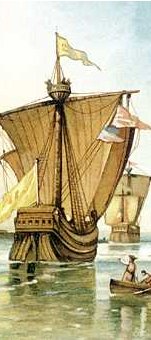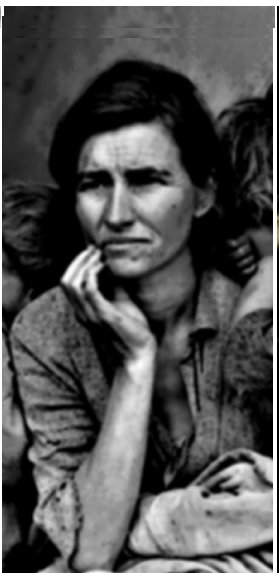a Lasting Impact Nishant Gotmare
Robert H. Jackson and Edward Castillo are borderland
scholars teaching respectively at Texas Southern University and Sonoma
State University.
Castillo is a Cahuilla and Luiseño Indian. In his lectures and interviews, he
bashes the government for its dislike of Indian casinos. Jackson
has written other books on Native Americans, such as From
Savages to Subjects: Missions in the History of the American Southwest (Latin
American Realities).
Indians, Franciscans, and
Spanish Colonization: The Impact of the Mission System on California Indians by
Robert H. Jackson and Edward Castillo, is an ethnohistory book which examines
the establishment of the Mission System by Franciscans in Alta California, and
its effects on the lives of the numerous and distinct Native American tribes
that lived in the region. Jackson and Castillo state that ¡§Columbus¡¦s
voyage of discovery to the New World signified the
beginning of complex processes of change among the native peoples encountered
by Europeans in the Americas.¡¨1 From the very beginning,
Spanish colonization of the Americas
affected countless generations of Natives, and many times, the effect has left
the Native population in ruins. Many rich civilizations in the Central
America crumbled beneath the Spanish conquistadores, and it was
destined to happen again, a few centuries later and on a smaller scale, in the
region of Alta California. Between the years of 1769 and
1823, the Franciscans (members of the Catholic religious order) with the aid of
the Spanish, established the Mission system in Alta
California. Thousands of native Californian Indians were taken
into Missions to be converted, and then put to work on the Mission
lands. In this book, Robert H. Jackson and Edward Castillo draw conclusions
about how the Mission system impacted Indians, to what
extent it impacted Indians, and how the Mission system
affected the Spaniards and Franciscans.
Indians, Franciscans, and
Spanish Colonization is split into five sections (or chapters) which contain
numerous sub-sections and a final appendix consisting of numerous detailed data
tables and graphs. The first chapter of the book focuses on the Political
economy of the Alta California Missions. The first section of the chapter cites
the numerous goals of missions, such as ¡§establishing self-sufficiency in
foodstuffs and clothing for Indian converts¡¨ and ¡§Franciscan
missionaries¡Kagreed to supply surplus grain and clothing to military garrisons
stationed in the region, thus reducing the cost of the royal government of
maintaining troops in the province to protect the missions.¡¨2In the following section,
the authors examine the importance of land and labor, and how they were key
factors in the functioning of the mission economy. Due to the importance of labor,
Franciscans forced men and women to labor in various tasks such as farming,
ranching, construction, and maintenance. The following paragraph talks about
the agriculture and ranching and their importance to a mission¡¦s economy.
Agriculture was important to the economic success of the missions; however
frequent rains damaged crops heavily. Ranching provided meat and raw materials
for textiles, leather goods, soap and candles. In this chapter, the authors
also provide criticisms on certain historians and archaeologists. In one of the
sub-sections, the authors begin a paragraph criticizing historian David
Hornbeck and archaeologist Jules Costello. They assert that ¡§Hornbeck and
Costello¡¦s model of the political economy of California
missions and particularly their claims of a shift¡Kdoes not withstand close
analysis. To begin with it ignores¡K¡¨3
Jackson and Castillo criticize the way that Hornbeck and Costello ignore
the factors that influenced the creation of the mission system, and how
Hornbeck and Costello disregard the impact of Mexican and Spanish policies
concerning the economy of California. Following
the criticisms, the authors present a small graph displaying statistical data
about mission economy, and the chapter ends with a small paragraph on labor, in
which the authors examine the Indians¡¦ work hours in the missions.
The following chapter focuses on
the aspects of social and cultural change in the Mission
communities. In the first sub-section, the authors state that one of the
primary goals of the Franciscan mission program. They state ¡§One of the primary
objectives of the Franciscan- directed mission program in Alta
California was the transformation of the culture and world view of
the Indian converts.¡¨ 4 Significant
aspects of Indian material culture changed under the direction of the
Franciscans; however few cultural traditions survived in a handful of missions.
Jackson and Castillo also explain that the second objective on the missions¡¦
acculturation program was the conversion of Indians to Catholicism. The
Franciscans¡¦ desire to completely control Indian tribes in areas surrounding
the missions led them to force Indians to either convert or suffer severe
punishment. After explaining the reasons for the survival of traditional
beliefs (such as the Indians simply rejecting the Franciscan beliefs, and the
failure of Franciscans to imprison many Indian religious leaders and shamans),
the authors begin a small sub-section on the traditional and new Indians,
explaining the rise of the alcaldes (commoners brought to power because they
cooperated with the Spaniards). To conclude the section, the authors examine
changes in gender roles. The authors explain that the men took care of hunting,
fishing, and sometimes gathering plant food. The women took care of baskets,
clothing, household chores, water and wood, and the children. However, it was
not uncommon to see a mix in gender tasks.
In chapter three, Jackson and
Castillo look at the demographic collapse in Alta California
missions. The chapter begins by looking at the origins of epidemics in the
missions, which leads to an overview of the impact of epidemics, and to what
extent they contributed to the demographic collapse in the missions of Alta
California. The authors present the fact that ¡§The first severe
epidemics occurred in the decade of 1800-10 and crude death rates were highest
during that decade¡K¡K¡¨ 5The
topic of nonepidemic causes of demographic collapse is also brought up in this
chapter. It is acknowledged that epidemics caused high mortality rates, but it
is also pointed out that ¡§relatively few epidemics broke out in Alta
California missions, and the three most serious outbreaks occurred
after 1800.¡¨ 6 From the
analysis on epidemics, the authors draw a conclusion explaining that epidemics
were not the major cause of the demographic downfall of missions. The real
cause involves the diet of the Indians and unsanitary conditions of missions.
The authors state that the diet and of the Indians is a very controversial
topic among historians since some recorded documents state that ¡§the urban poor
could and should continue to live, no matter how unbalanced that diet might
be.¡¨ 7 However, other
recorded documents state that ¡§even with the inclusion of meat in the Indian
diet; the mission diet was still deficient, below the optimum in calories and
nutritional balance for providing the body with sufficient resistance to
diseases.¡¨ 8The amount of
nutrition in the diet of the Indians was low, and as a result, many Indians
contracted diseases which shattered their already weakened immune systems. The
authors also criticize the calculations of historian Richard Herr, who did a
study on the mean consumption of peasants in Alta California,
by stating that Herr¡¦s figures do not reflect actual consumption of food. Following
the examination of diets, a new paragraph concerning labor issues and social
disruption is introduced. Mission economies depended
upon an abundant labor supply; however with the high death rates, missions had
to constantly replenish their labor force to maintain their economy. However,
this constant replenishment was considered unstable since many Indians ran away
in protest. The section ends with two minor paragraphs concerning changes in
Indian world view, and psychological dislocation. Chapter four is a short, but
interesting chapter which focuses on the resistance and social control in the
Alta California Missions. Jackson and Castillo begin by introducing two types
of resistance: Primary and Secondary. Primary resistance ¡§was the first offered
to the incoming Spaniards. It was generally localized, and only rarely did
village leaders for larger coalitions¡¨ 9
Primary resistance was important because it slowed down the Franciscan mission
program. The constant attacks impeded the development of many missions, and the
occasional lack of soldiers sometimes resulted in the deaths of many
missionaries. Secondary resistance ¡§occurred a generation following the
establishment of the missions and involved Indians born in the missions and
Indian converts who lived at the missions for varying periods of time.¡¨ 10 Secondary resistance
involved many large scale Indian flights, and missionaries, such as Juan Martin
and Mission San Miguel, became targets of murder attempts. Missionaries used
social control rigorously in the missions. The authors examine the various
methods used to intimidate Indians into obedience. Public floggings were common
in missions, and missionaries limited the mobility of converts to a point where
Indian mothers would kill newborns in protest.
Chapter five is the final chapter
of the book. The chapter examines the mission secularization and development of
Alta California in the 1830s and 1840s, as well as the
policies and actions of the Mexican Government toward secularization
(separation of Indians from the missions). The authors state that ¡§conservative
politicians dominated Mexico
during much of the first federal republic and prevented the secularization of
the frontier missions¡K including the Alta California
missions.¡¨ 11 From the
liberals¡¦ point of view, the mission system did not belong in California,
and it needed to be eliminated in order for the frontier to progress and
integrate the Native American population. The conservatives, however, felt it
was necessary and prevented secularization of the frontier mission in California.
It wasn¡¦t until 1826 that the first emancipation decree freed a small number of
converts. The time between 1827 and 1828 was a time of large population
increase in the Los Angeles area.
In 1833, the second stage of emancipation emancipated all Indians living in
missions.
Jackson and Castillo¡¦s main point
is that ¡§The fundamental success of the Spanish colonial system was due to its
ability to exploit sedentary Indian populations.¡¨ 12 Overall, their
statement is true. Without an Indian labor force, the missions¡¦ economy would
have been in shambles, and without the Indians, the Spanish would never have
acquired so much rich land. With the Indians manning the labor force, the
missions had large amounts of leatherworking goods, textiles, meat, and raw
materials, which aided the Spanish army and created a good amount of revenue
for the missions. The missions also took up the policy of ¡§renting¡¨ out Indians
to new settlers. Many new settlers were migrating to Alta California
during this time period, and since many settlers were farmers who needed help
to start up their farms, the renting policy was a success. The authors explain
the need for social control in missions to achieve success. Publicly flogging
Indians, and restricting freedom of speech, and religion was vital in keeping
the Indians under control. Without vigorous social control, the missionaries
would not have been able to command the Indians.
Jackson and Castillo, state their
opinions on this issue often during the course of the book. They write in a way
that shows that they are mostly anti-missionary/anti Spanish on the issue of
the mission system. They seem to believe that construction programs on missions
were manifestations of forced labor. 13
They also conveniently leave out certain amounts of data regarding
Indians who actually sided with Spanish and the Franciscans 14 In the book, Jackson and
Castillo criticize various historians, archaeologists, and scholars as well. In
chapter three, they both criticize Ann Stodder, who stated that malnutrition
was an important factor in the demographic collapse of the missions. Jackson
and Castillo criticize that ¡§Stodder did not provide empirical evidence to
substantiate her arguments.¡¨ 15 Jackson
and Castillo are quick to point out the faults of the historians in the
criticisms they make, but they tend to leave out data that would be considered
important, such as the more information about what the historians they
criticized said. They don¡¦t incorporate other potentially important statements
made by the criticized historians about the impact of the mission system on
Indians. As stated in the one of the literary critiques, Jackson and Castillo
have a revisionist view of history. They critically reexamine historical facts and
try to rewrite history with different interpretations of existing information,
and use statistical data, and literary criticisms to argue against current
views on the impact of the mission system on Indians.
One of the prominent literary
critiques of Indians, Franciscans, and Spanish Colonization is by Jack
S. Williams and Anita Williams of Arizona
State University.
In this critique, both authors state ¡§It offers very
little new information in support of its revisionist thesis¡K Jackson and
Castillo's goal of integrating the California mission story into the larger framework of Latin American
history is not achieved. 16 In
this literary critique, both Williams state that Jackson and Castillo have
written a detailed book, but they have failed to reach their ultimate goal of
integrating the California missions into Latin American history. Williams also points
out that for a book which focuses on the transformation of the Indian people,
Jackson and Castillo offer very little information about aboriginal society. It
is also stated in the review that Jackson and Castillo fail to address the
point of view of the Indians that actually supported the change in life styles.
In fact, not all missions were as bad as Jackson and Castillo have made them
out to be. While many Spanish missions ruined the lives of Indians, some
actually made their lives more pleasant. The exact reasons how missions made
the Indians¡¦ lives more pleasant are complex, however not all Indians were
forced onto missions, so it is obvious that there was something positive that
attracted the Indians to work at the missions.
Another literary critique of this book is made
by Sue A. Wade of San
Diego State University. In her critique, Wade states ¡§One stated goal of
the authors is that these new interpretations are additionally valuable in
comparison with other Spanish borderland regions¡K ;however, it is this goal that the
authors leave only lightly touched.17
In her critique, Wade states that Jackson and Castillo have gone above and
beyond in acquiring statistical data, and that their approach toward this data
is different from other historians focusing on the mission system. However, she
also states that the authors did not touch upon all the important subjects
regarding the Mission system in Alta
California, and overall failed to achieve their stated goal.
It is clear to see that Robert H.
Jackson and Edward Castillo have thoroughly researched their topic, and the
amount of detail and evidence these two authors have provided shows their
understanding of the subject. However, Jackson and Castillo tend to be a little
¡§one-sided¡¨ in their views. When discussing epidemics, they assert: ¡§The lack
of medical attention during epidemic outbreaks probably increased mortality.
The general belief held by missionaries that epidemics were punishment sent by
God frequently limited their response to outbreaks.¡¨ 18 Here, Jackson and Castillo make it sound as if the
entire problem should have been blamed on the missionaries. However, they leave
out the fact that the Spanish government could have done something to aid the
Indians. If the government was profiting off the labor of the Indians, wouldn¡¦t
the government have done something to stop the diseases from further destroying
their labor force? Jackson and Castillo¡¦s failure to present the information
concerning the response of the government to this issue shows their biased
feelings.
The events taking place in Alta
California in this time period were not directly linked to events
occurring in Eastern United States. The years between
1769 and 1823 in American were mainly concerned with the American Revolution
and British rule over the colonies. However, the Spanish were involved in the
war, as well as the signing of the Adams-Onis treaty, which ceded the territory
of Florida to the United
States. The Mexican War of Independence,
which took place from 1810 to 1821, involved the Spanish and the Mexicans, but
it did not affect the Missions or Indians in Alta California
significantly. The events that occurred in California
were distinctive from the events occurring in the rest of the country. The only
other Spanish missions at the time were in Texas,
but many missions there were either running slowly or were completely inactive.
Jackson and Castillo also state that unlike Texan missions ¡§California
missions more closely approached the utopian idea of Christian communities that
influenced several generations of Franciscans in the Americans.¡¨19
Jackson and Castillo see California
as important to the Southern parts of the United
States. ¡§California
missions contributed to the political and economic objectives of the Spanish
and Mexican governments.¡¨ 20 They
state that the labor and goods provided by the missions substantially reduced
the cost of maintaining the military on the frontier. The mission system was
obviously a success for the Spanish and Mexican government, since they spent
thousands of dollars to aid the missions and keep the system afloat, but gained
a hefty profit in the end.
The level of detail and evidence
in this book is extraordinary, but the fact that Jackson and Castillo leave out
a few ¡§minor¡¨ details here and there somewhat destroys the credibility that
these two authors have. As seen in quotes above, Jackson and Castillo
conveniently disregard details which might go against their ¡§anti-Iberian,
anti-missionary, anti- European, and anti colonist perspective.¡¨ 21As stated by Jack and
Anita Williams. The critiques done by Jackson and Castillo on historians are,
like their statements and opinions, ¡§one-sided¡¨. Their criticisms of Hornbeck
and Costello show a completely one-sided perspective. They state very little of
what Hornbeck and Costello actually said, but write a whole paragraph of
criticisms about how Hornbeck and Costello disregard a number of factors
regarding acculturation and the political economy of the missions. While the
book is well written, detailed, and contains numerous pages of data, the
opinions of Jackson and Castillo
get in the way of the actual facts. Their insistence upon inserting their own
opinions, lead them to ultimately fail in achieving their stated goal.
1. Jackson, Robert H, and Castillo Edward. Indians,
Franciscans, and Spanish Colonization: The Impact 2. of the Mission
System on California Indians. Albuquerque:
University of New
Mexico Press, 1995. 1.
3. Jackson, Robert H, and Edward Castillo 11.
4. Jackson, Robert H, and Edward Castillo 15.
5. Jackson, Robert H, and Edward Castillo 31.
6. Jackson, Robert H, and Edward Castillo 41.
7. Jackson, Robert H, and Edward Castillo 42.
8. Jackson, Robert H, and Edward Castillo 43.
9. Jackson, Robert H, and Edward Castillo 45.
10. Jackson, Robert H, and Edward Castillo 73.
11. Jackson, Robert H, and Edward Castillo 73.
12. Jackson, Robert H, and Edward Castillo 89.
13. Jackson, Robert H, and Edward Castillo 1.
Williams, Jack S. and Williams-Cohen, Anita. ¡§Review¡¨.
Humanities and Social Sciences Online.1 June 2008 < http://www.hnet.org/reviews/showrev.cgi?path=9109851380190>
14. Williams, Jack S. and Anita Williams-Cohen 1.
15. Jackson, Robert H, and Edward Castillo 45.
16. Williams, Jack S. and Anita Williams-Cohen 1.
17. Wade Sue A. ¡§Book Review¡¨. San Diego Historical Society.1
June 2008 < http://www.sandiegohistory.org/journal/97winter/indians.htm>
18. Jackson, Robert H, and Edward Castillo 42.
19. Jackson, Robert H, and Edward Castillo 108.
20. Jackson, Robert H, and Edward Castillo 107.
21. Williams, Jack S. and Anita Williams-Cohen 1.










